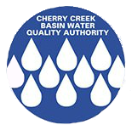Permit Compliance
Control requirements for point source dischargers were effective in reducing phosphorus concentrations to the watershed and Reservoir.
All of the WWTFs in the basin met their total phosphorus (TP) and total inorganic nitrogen (TIN) discharge limits in 2023.
Wastewater treatment facilities (WWTFs) in the basin are required to meet stringent total phosphorus (TP) discharge permit limits of 0.05 mg/L as a 30-day average. These control requirements effectively reduce phosphorus concentrations to the watershed and Reservoir. Point source discharges contribute less than 3% of total phosphorus loading to the Reservoir.
WWTFs in the basin provide TP removal through advanced wastewater treatment processes, followed by direct discharge or further treatment through land application. Some WWTFs are also required to remove total inorganic nitrogen (TIN) to meet permit limits. There are currently five permitted WWTFs in the basin that discharge to Cherry Creek waters. Another, Plum Creek Water Reclamation Authority, is located outside the watershed but applies some of its treated effluent as irrigation water within the watershed. All six of these facilities have TP effluent limits of 0.05 mg/L (some of the lowest in the state). Pinery, PWSD, and Stonegate have daily maximum TIN limits of 10 mg/L with associated compliance schedules that will require even stricter TIN limits be achieved by the end of 2026 (based upon the public-noticed permits for these three facilities that were issued in April 2022, final permits have not yet been issued by the WQCD for these three facilities). Additionally, the Plum Creek facility has a daily maximum nitrate limitation of 10 mg/L, and PWSD has a 30-day average nitrite limitation of 0.05 mg/L, that will also become effective upon the completion of the compliance schedule in 2026.
Wastewater and industrial process wastewater sources, as well as reclaimed water treaters, are limited in the amounts of phosphorus they are allowed to discharge to the Cherry Creek Reservoir watershed. Limits contained in the point source discharge permits in the basin effectively reduce nutrient concentrations in the receiving streams. For example, TP discharge limits for WWTFs, which for most dischargers are less than 0.05 mg/L TP as a 30-day average, are significantly less than the flow-weighted TP concentrations currently entering the Reservoir from aggregated sources (surface and groundwater inflows, precipitation). Drinking water treatment plant discharges are required to meet a phosphorus effluent limit of 0.2 mg/L.
All of the WWTFs in the basin met their TP and TIN discharge limits in 2023.

Effluent Concentrations
* The flow weight avergage concentration must be ≤ 0.005 mg/L TP, divided by the land application return flow factor.
** TP Limit is a 30-day average unless a 90-day average is approved by the Division at the request of the discharger.
*** No TIN permit limit.
